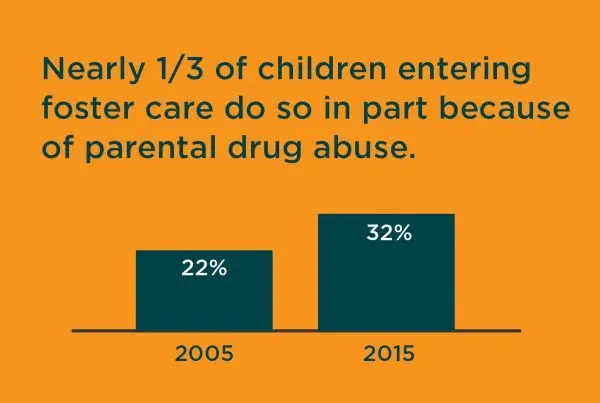5 things to know about the opioid epidemic and its effect on children
Opioids are highly addictive drugs, available in illegal forms like heroin, or legal ones like oxycodone, hydrocodone, or morphine, which are available through a prescription. A drastic increase in the abuse of prescription opioids has gained national attention on multiple fronts, and for good reason. This is what you need to know about the epidemic and how it affects children.

1Opioid abuse has increased significantly over the last 20 years.
2At least 2 million children annually have a parent who uses illicit drugs, including opioids.
According to the National Survey on Drug Use and Health, from 2007 to 2012 an estimated 21,000 pregnant women (ages 15 to 44) annually misused opioids during the month prior to being surveyed. The survey also found that each year between 2002 and 2007, an estimated 2.1 million children under 18 lived with a parent who was dependent on or abused illicit drugs within the year prior to taking the survey (there is no specific estimate for opioid use). Given the dramatic increase in opioid abuse, dependency, and overdose deaths, it is likely current estimates would be higher, and that a substantial percentage would be attributable to opioids as opposed to other drugs.
3Opioid abuse by parents puts children's health and safety at risk.
Infants with mothers who used drugs or alcohol during pregnancy are more likely to have a range of physical, behavioral, and cognitive problems. Neonatal abstinence syndrome (NAS) is a post-birth withdrawal syndrome caused primarily by prenatal exposure to opioids; it is characterized by tremors, excessive crying, poor feeding, and rapid breathing. The incidence of NAS increased by 300 percent between 1999 and 2013, from 1.5 per 1,000 births to 6.0 per 1,000 (according to an analysis of the 28 states with available data). Substance abuse can also result in ineffective or inconsistent parenting, leading to children’s basic needs–such as adequate nutrition, supervision, and nurturing–going unmet.
4The number of children entering foster care due to parental drug abuse is rising.
Children of parents with substance use issues are more likely than their peers to experience abuse and neglect, to be referred to the child welfare system, and to be placed in foster care (overall and for longer periods of time). While there are many anecdotal reports linking the opioid epidemic to increases in the number of children in foster care, there is not enough available data to make a direct link: when a child enters foster care due to parental drug abuse, federal child welfare data do not indicate what type of drug the parent was abusing, only that drug abuse was severe enough that the parent was not able to adequately care for their child. Parental drug abuse is the second-most-common reason for foster care entry, and it is on the rise. In 2005, 22 percent of children who entered foster care did so at least partially because of parental drug abuse; in 2015 that number was 32 percent, according to Child Trends’ analysis of 2015 Adoption and Foster Care Analysis and Reporting System data. Neglect–the most common reason for foster care entry–is intertwined with substance use, and has also increased in recent years.
5States are responding to the opioid epidemic in diverse and innovative ways.
Across the country, states are responding to the opioid epidemic through research, legislation, and new interventions. New data collection efforts help states target resources and services to families that need them most: the Public Children Services Association of Ohio, for example, conducted a survey of county child welfare agencies to gain a better understanding of how opioids are impacting Ohio’s child welfare system. In 2016, Massachusetts passed legislation limiting first-time opioid subscriptions to 7 days, and seven other states have followed suit. Other states have adopted similar voluntary guidelines for doctors in an attempt to prevent opioid dependence before it starts. To address substance abuse and build healthy families, many states are implementing innovative or evidence-based interventions such as family drug courts and family-focused residential treatment centers. While helping families address addiction, these kinds of interventions also try to keep families together or to shorten time to reunification, in the case of children who have already been removed from their families.
© Copyright 2024 ChildTrendsPrivacy Statement
Newsletter SignupLinkedInThreadsYouTube